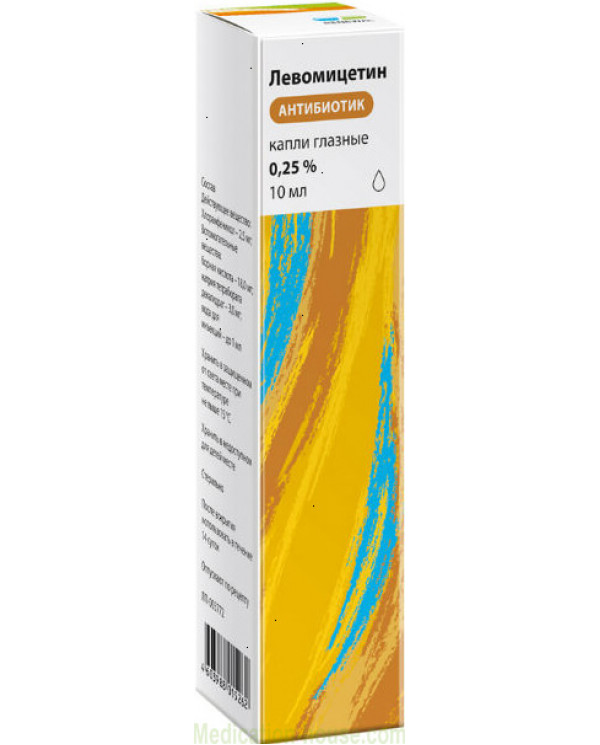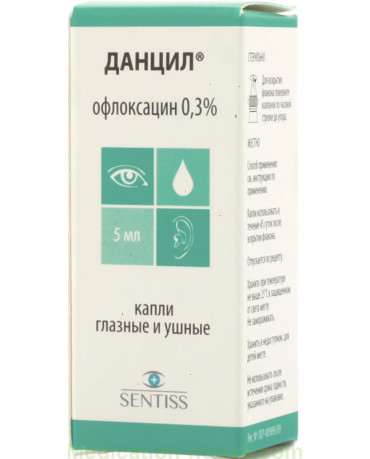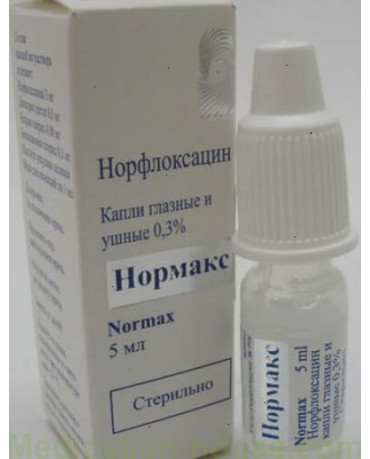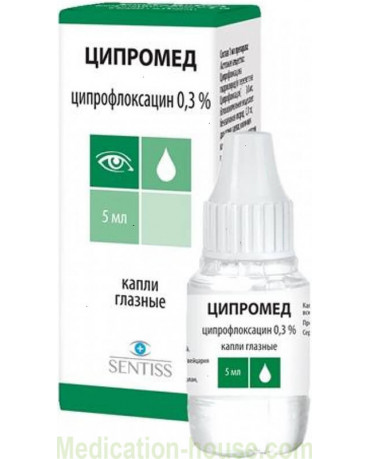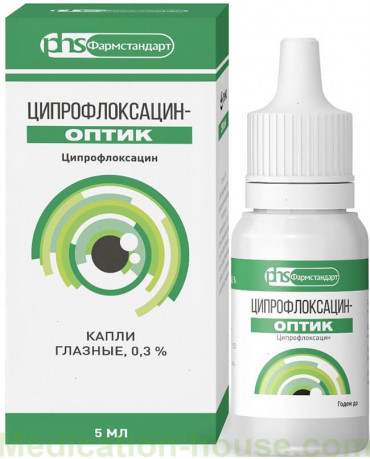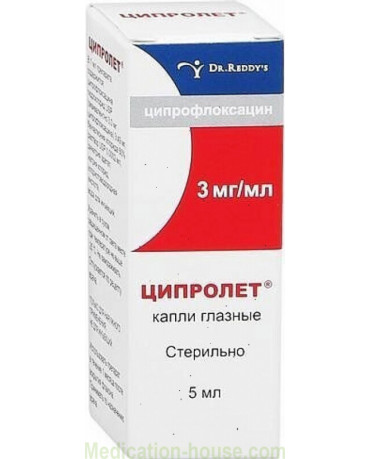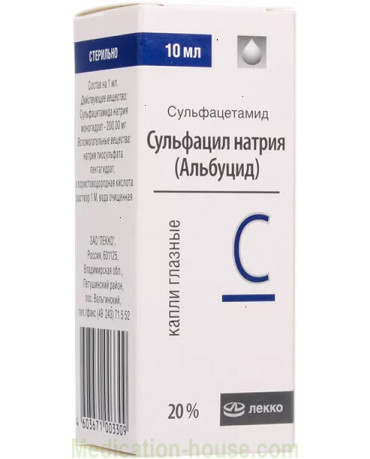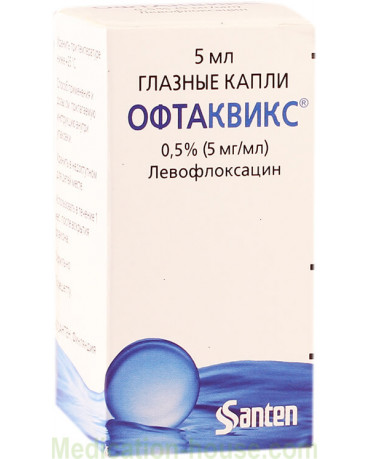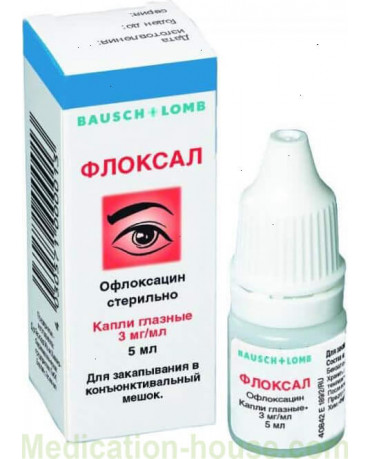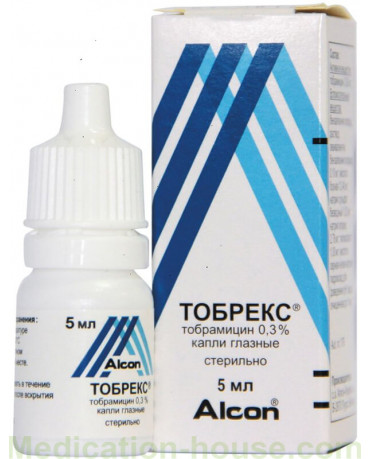Instruction for Levomycetin eye drops
Reed more and buy Levomycetin eye drops here
Composition and pharmacology of the drug
Levomycetin is an ophthalmic drug with a pronounced antimicrobial effect. ATX code - S01A A01. The active composition of the drops is represented by chloramphenicol, a broad spectrum antibiotic. Its content in 1 ml of solution is 2.5 mg. Auxiliary components:
boric acid;
injection water.
The liquid is sold in tinted glass bottles with a dispensing nozzle or in polymer droppers with a volume of 1, 1.5, 2, 5 or 10 ml. Taking into account the fact that after opening the original packaging, the contents must be used within 15 days, it is better to purchase a small amount of funds.
The eye drops are bacteriostatic. Chloramphenicol is a fat-soluble substance that penetrates through membranes into bacterial cells, where it binds to ribosomal subunits. As a result, the inclusion of amino acids into peptide chains is blocked, protein biosynthesis is disrupted, bacteria cannot grow and multiply. The number of pathogens stabilizes, the body copes with them on its own.
The compound is highly toxic, but when applied topically, its systemic exposure is minimized. Therefore, drops can be prescribed even to small children.
Pharmacokinetics and pharmacodynamics
The influence of Levomycetin eye drops extends to many bacterial pathogens, including:
strepto- and staphylococci;
hemophilic and Escherichia coli;
gonococci;
chlamydia;
rickettsia;
actinomycetes;
shigella;
pneumococci;
some strains of Neisseria, Enterobacter, Moraxella, Mycoplasma, Treponema, anaerobic bacteria, etc.
The medication copes with pathogens that are immune to the action of streptomycin, penicillin, tetracycline, sulfanilamide drugs, as well as some large viruses. But it is useless in the fight against acid-resistant microorganisms, Pseudomonas aeruginosa, clostridia, parasitic fungi, protozoa.
Pharmacokinetic data with topical chloramphenicol use are limited.
After instilling the medicine, it is found in various structures of the eyeball, such as:
cornea;
Iris;
vitreous body;
front and back cameras.
The highest concentration is determined in the aqueous humor of the eye half an hour after instillation. The agent is not absorbed into the lens; a small amount enters the systemic circulation. It is excreted from the body in the urine within 4-7 hours.
Resistance to the action of this antibiotic in pathogens forms slowly, and resistance to other drugs does not develop against the background of its administration. With normal liver function, the active ingredient does not stay long in the tissues. Prolonged use of Levomycetin increases the likelihood of developing insensitive microflora and the appearance of adverse reactions.
Indications for use
The agent is prescribed for the treatment of ophthalmic diseases of a bacterial nature, which are provoked by the activity of pathogens susceptible to the action of chloramphenicol. It will not relieve redness and irritation if the symptoms are caused by other causes, such as an allergic reaction. The drug is not a first-line drug. Most often, they resort to his help when other antibiotics cannot cope with the disease.
Indications for appointment:
blepharitis, barley on the eye, meibomitis;
conjunctivitis;
blepharoconjunctivitis;
dacryocystitis;
endophthalmitis;
iridocyclitis;
keratitis of bacterial origin, secondary infection against the background of neurogenic keratitis;
sclerites.
For the prevention of bacterial infection, the drug cannot be used.
Application methods
Levomycetin eye drops are applied topically for ophthalmic purposes. Before starting treatment, you should consult a doctor. The solution is introduced by instillation (instillation) into the conjunctival sac. To do this, the head is slightly tilted back, the gaze is directed upward, the lower eyelid is carefully pulled downward. The nozzle of the dispenser is directed into the formed pocket and the agent is instilled. In this case, the bottle should not come into contact with fingers, eye surface or eyelid. Then you need to close your eyelids and briefly press your finger to the inner corner of the palpebral fissure.
Before starting the procedure, you need to wash your hands. Both eyes should be treated, even if only one is affected. If a dispensing tip or matching nozzle is not available, a pipette must be used. If there is purulent discharge, it is advisable to remove them in advance by rinsing the eyes with boiled water.
The frequency of administration and the duration of the treatment course are determined by the doctor individually. This takes into account the existing symptoms, the severity of the pathology, the patient's age, the effectiveness of the treatment. The duration of use is from 5 days to 2 weeks. A repeated course is undesirable.
The tool is not intended for treating the ears and nasal cavity, but in practice, doctors sometimes prescribe it for otitis media, rhinitis, and related pathologies. It is prohibited to use it as drops in the nose and ears on your own initiative.
If absolutely necessary, the composition can be used as a solution for lenses. It does not clean contact lenses properly, so they should be placed in a container with special fluid as soon as possible.
Recommended dosage
Children need to inject 1 drop of the solution into each eye three times a day. Adults - 1-2 drops with an interval of 4-6 hours. In some cases, in a hospital, instillations are carried out every hour, gradually reducing the frequency of application of drops as the inflammation decreases. For representatives of the older age group, dose adjustment is not required.
At what age is Levomycetin eye drops prescribed
In newborns, the active ingredient can accumulate in the body, affecting the bone marrow. As a result, hematopoiesis (hematopoiesis process) is disrupted, quantitative changes in the composition of the blood occur, including irreversible ones, leading to death. Therefore, for the treatment of a child during the first 4 weeks of life, it is used only if absolutely necessary. At the age of 2 years, it should be prescribed with caution, monitoring of the picture of peripheral blood is required.
Precautions
When using chloramphenicol solution in parallel with other eye agents (drops, ointments), a 15-minute interval must be maintained. Ointment preparations are used after drops.
During eye treatment, it is advisable to refrain from using contact lenses. If necessary, put them on at least 30 minutes after instillation.
If, after 2 days of therapy, no positive dynamics is observed or the patient's condition has worsened, this medication should be replaced with another antibacterial agent. Unauthorized use of the solution by adults should not exceed 3 days. For children, Levomycetin can be used only in consultation with a doctor (ophthalmologist, pediatrician).
During therapy, the quantitative composition of peripheral blood should be monitored. Research is carried out before and after treatment. With prolonged admission and repeated course, analyzes are done at appropriate time intervals.
Overdose cases with topical application of the medication have not been recorded. If a large amount of liquid is injected into the eyes, rinse them thoroughly with water. The same is done when there is a strong burning sensation, swelling, profuse lacrimation and other similar effects. If these symptoms persist, seek medical attention.
Special instructions
Uncontrolled use of an antibiotic unnecessarily, including with a mild form of the disease, prolonged use, exceeding the dosage can lead to severe complications.
Pregnancy and lactation
Studies of the effect of the drug on pregnant and lactating women have not been conducted. During its testing on animals, it was found that the active substance overcomes the placental barrier and is excreted in breast milk. It is contraindicated to use the medication during pregnancy. The exceptions are cases where the likely benefit outweighs the potential risk. In case of hepatitis B, the baby should be weaned during treatment.
Impact on the control of mechanisms
Levomycetin eye drops can cause transient blurred vision, eye irritation, and other undesirable effects. In this regard, within 1 hour after instillation, and sometimes longer, until the work of the visual analyzer is fully restored, it is necessary to refrain from driving a car, operating potentially dangerous mechanisms, and performing work requiring increased visual control.
Diseases of the liver and kidneys
With renal-hepatic pathologies, the transformation and excretion of Levomycetin eye drops slows down. This can cause its accumulation, increased systemic impact. In severe violations of the liver or kidneys, the use of drops is contraindicated. In other cases, it is enough to reduce the frequency of administration of the solution, provided that the condition of the liver is monitored.
Contraindications and side effects
The medication cannot be used when:
intolerance to chloramphenicol, thiamphenicol, azidamphenicol, boric acid;
violation of the hematopoietic function of the bone marrow;
acute intermittent porphyria;
erythrocytopathy;
severe renal-hepatic dysfunction.
The drug should not be administered to newborns, as well as to women at any stage of pregnancy and during lactation (without refusing to feed).
Caution required:
if the patient has previously taken cytostatics or underwent a course of radiation therapy;
have recently had eye surgery or laser vision correction (up to 6 months);
with injuries of the eyeball or adjacent structures;
with psoriasis, eczema, fungal infections of the skin, nail plates (onychomycosis);
in the presence of a skin rash in the periorbital area.
The treatment of children of the younger age group should be carried out under medical supervision.
It is not recommended to combine this medication with penicillins, cephalosporins, Erythromycin, Lincomycin, Clarithromycin, barbiturates. Its use in conjunction with sulfa and cytostatic agents increases the risk of developing adverse symptoms characteristic of chloramphenicol.
After treatment with liquid, itching and burning sensation appear in the eyes, and a temporary impairment of vision clarity is often noted.
Other side effects are possible:
local allergic reactions (reddening of proteins, increased tearing, discomfort or pain, photophobia, swelling of the eyelids);
dizziness;
migraine;
fever;
skin rash, erythema, urticaria;
angioedema;
bone marrow hypoplasia;
quantitative changes in the composition of the blood (a decrease in the level of erythrocytes, leukocytes, platelets);
accession of a secondary infection, mycosis.
There have been isolated cases of the development of aplastic anemia, including irreversible, with a fatal outcome, therefore, the solution is not prescribed if its administration earlier provoked bone marrow failure. If the solution accidentally gets into the digestive tract, nausea, vomiting, and dyspepsia are possible.
Due to insufficient development of the liver in children during the first months of life, the metabolism and excretion of chloramphenicol may be impaired. As a result of its cumulation, a "gray" syndrome develops.
Typical symptoms:
gray tint of the skin, mucous membranes;
drop in blood pressure;
decrease in body temperature;
violation of respiratory function;
muscle weakness;
vascular collapse.
There is a high probability of falling into a coma and death of the child.
Reviews about Levomycetin eye drops
Nadezhda, 36 years old
It is a reliable remedy for conjunctivitis and barley. Repeatedly saved them with severe inflammation. If you start dripping when the first symptoms of the disease appear, then you can be cured in 3-4 days. The drug is well tolerated at any age. If you need to choose Albucid or Levomycetin, then it is better for children to bury the latter, because it does not cause discomfort. Their mechanism of action is different, but the area of application is similar.
Anton, 29 years old
A good medicine for redness and inflammation of the eyes. The too low price confused me a little. But doubts were in vain. I felt relief the very next day: the swelling subsided, my eyes stopped watering. Thanks to the drug, I was able to do without sick leave.
Tatiana, 51 years old
The husband was diagnosed with keratitis, and was prescribed a solution of Levomycetin eye drops. The medicine did not suit him, he had to use another antibiotic.
Tamara, 44 years old
The drops were prescribed to a one-year-old grandson. It was scary to drip an antibiotic into the child's eyes, but washing with tea and chamomile broth did not help, so there was no choice. The grandson tolerated the burial procedure well and quickly recovered. A few days later, I showed the same symptoms, I had to try the medicine on myself. The solution does not sting, does not cause blurring, double vision, it helps both children and adults well.
Terms of sell
You can buy Levomycetin eye drops without a prescription.

